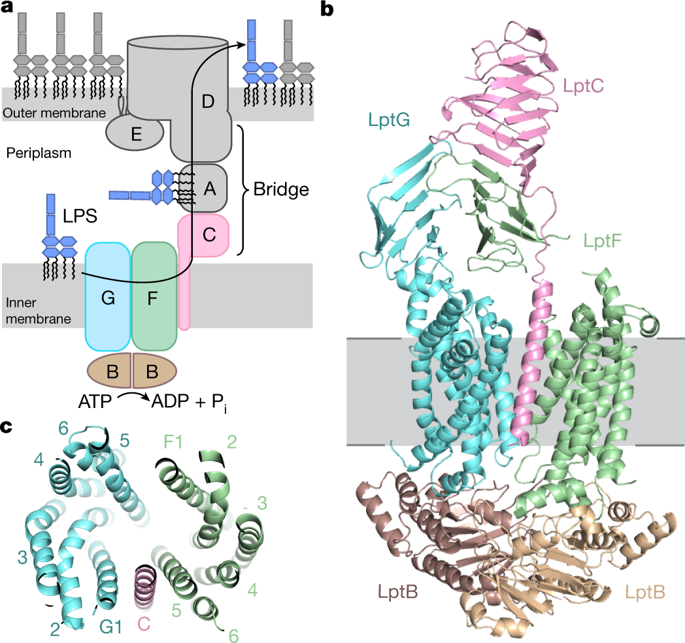Our official English website, www.x-mol.net, welcomes your
feedback! (Note: you will need to create a separate account there.)
Structural basis of unidirectional export of lipopolysaccharide to the cell surface
Nature ( IF 50.5 ) Pub Date : 2019-03-01 , DOI: 10.1038/s41586-019-1039-0 Tristan W. Owens , Rebecca J. Taylor , Karanbir S. Pahil , Blake R. Bertani , Natividad Ruiz , Andrew C. Kruse , Daniel Kahne
Nature ( IF 50.5 ) Pub Date : 2019-03-01 , DOI: 10.1038/s41586-019-1039-0 Tristan W. Owens , Rebecca J. Taylor , Karanbir S. Pahil , Blake R. Bertani , Natividad Ruiz , Andrew C. Kruse , Daniel Kahne

|
Gram-negative bacteria are surrounded by an inner cytoplasmic membrane and by an outer membrane, which serves as a protective barrier to limit entry of many antibiotics. The distinctive properties of the outer membrane are due to the presence of lipopolysaccharide1. This large glycolipid, which contains numerous sugars, is made in the cytoplasm; a complex of proteins forms a membrane-to-membrane bridge that mediates transport of lipopolysaccharide from the inner membrane to the cell surface1. The inner-membrane components of the protein bridge comprise an ATP-binding cassette transporter that powers transport, but how this transporter ensures unidirectional lipopolysaccharide movement across the bridge to the outer membrane is unknown2. Here we describe two crystal structures of a five-component inner-membrane complex that contains all the proteins required to extract lipopolysaccharide from the membrane and pass it to the protein bridge. Analysis of these structures, combined with biochemical and genetic experiments, identifies the path of lipopolysaccharide entry into the cavity of the transporter and up to the bridge. We also identify a protein gate that must open to allow movement of substrate from the cavity onto the bridge. Lipopolysaccharide entry into the cavity is ATP-independent, but ATP is required for lipopolysaccharide movement past the gate and onto the bridge. Our findings explain how the inner-membrane transport complex controls efficient unidirectional transport of lipopolysaccharide against its concentration gradient.Crystal structures of a five-protein complex comprising the inner-membrane components of the bacterial lipopolysaccharide transporter provide insight into the mechanism of extraction of lipopolysaccharide from the inner membrane and its transport to the outer membrane.
中文翻译:

脂多糖单向输出到细胞表面的结构基础
革兰氏阴性细菌被内细胞质膜和外膜包围,外膜作为保护屏障以限制许多抗生素的进入。外膜的独特特性是由于脂多糖的存在1。这种含有大量糖类的大糖脂是在细胞质中制造的。蛋白质复合物形成膜对膜桥,介导脂多糖从内膜转运到细胞表面1。蛋白质桥的内膜成分包括一个 ATP 结合盒式转运蛋白,该转运蛋白为运输提供动力,但这种转运蛋白如何确保单向脂多糖穿过桥到达外膜尚不清楚2。在这里,我们描述了五组分内膜复合物的两种晶体结构,其中包含从膜中提取脂多糖并将其传递到蛋白质桥所需的所有蛋白质。对这些结构的分析,结合生化和遗传实验,确定了脂多糖进入转运体腔并到达桥的路径。我们还确定了一个必须打开的蛋白质门,以允许底物从腔体移动到桥上。进入腔内的脂多糖不依赖于 ATP,但 ATP 是脂多糖通过门并进入桥所必需的。我们的研究结果解释了内膜转运复合物如何控制脂多糖对其浓度梯度的有效单向转运。
更新日期:2019-03-01
中文翻译:

脂多糖单向输出到细胞表面的结构基础
革兰氏阴性细菌被内细胞质膜和外膜包围,外膜作为保护屏障以限制许多抗生素的进入。外膜的独特特性是由于脂多糖的存在1。这种含有大量糖类的大糖脂是在细胞质中制造的。蛋白质复合物形成膜对膜桥,介导脂多糖从内膜转运到细胞表面1。蛋白质桥的内膜成分包括一个 ATP 结合盒式转运蛋白,该转运蛋白为运输提供动力,但这种转运蛋白如何确保单向脂多糖穿过桥到达外膜尚不清楚2。在这里,我们描述了五组分内膜复合物的两种晶体结构,其中包含从膜中提取脂多糖并将其传递到蛋白质桥所需的所有蛋白质。对这些结构的分析,结合生化和遗传实验,确定了脂多糖进入转运体腔并到达桥的路径。我们还确定了一个必须打开的蛋白质门,以允许底物从腔体移动到桥上。进入腔内的脂多糖不依赖于 ATP,但 ATP 是脂多糖通过门并进入桥所必需的。我们的研究结果解释了内膜转运复合物如何控制脂多糖对其浓度梯度的有效单向转运。































 京公网安备 11010802027423号
京公网安备 11010802027423号